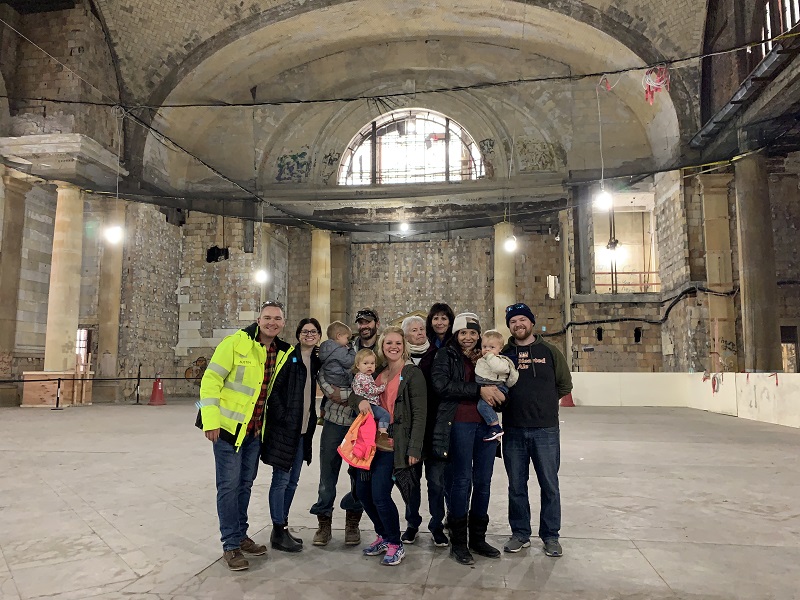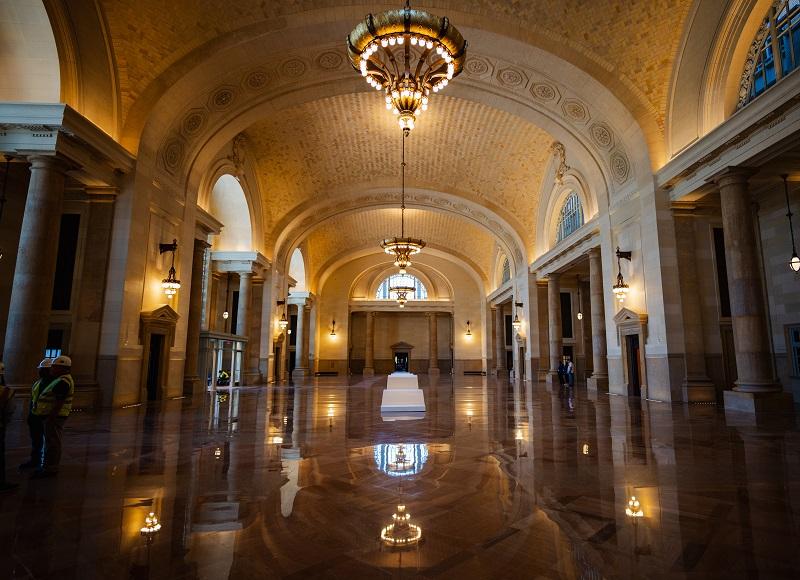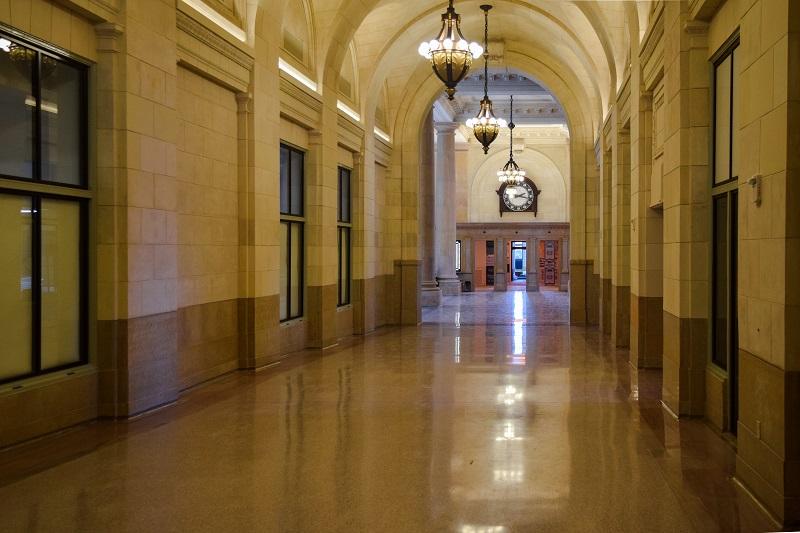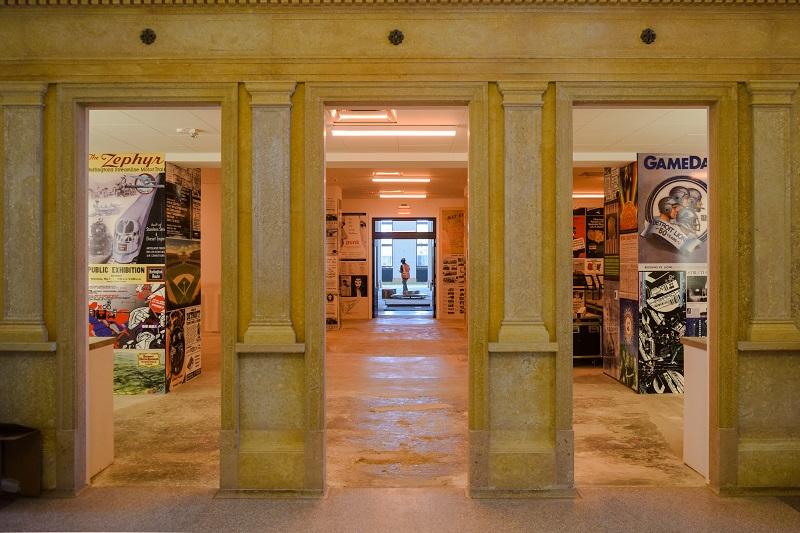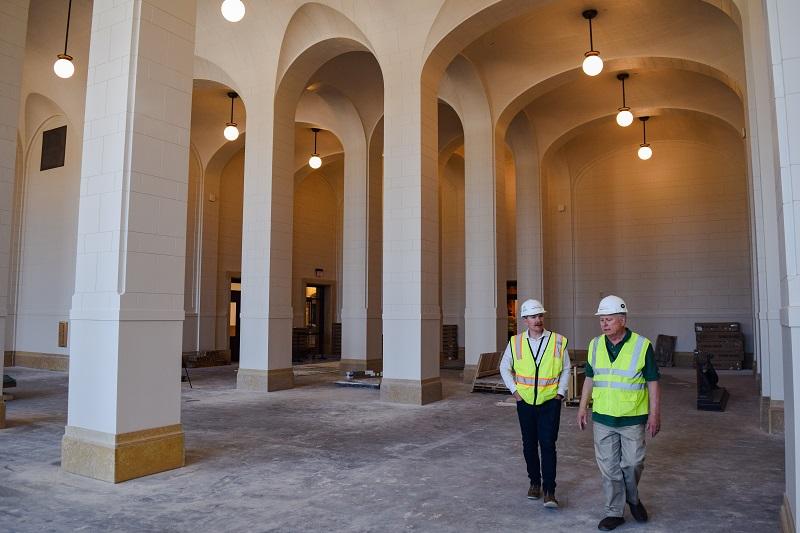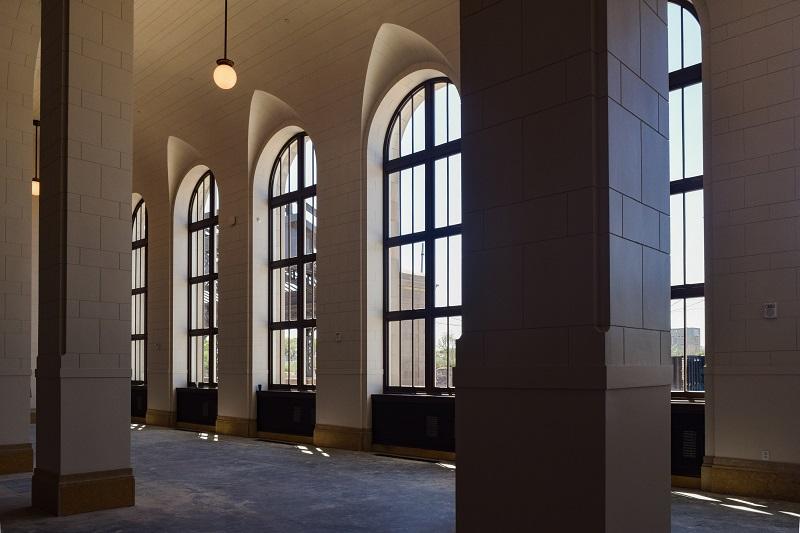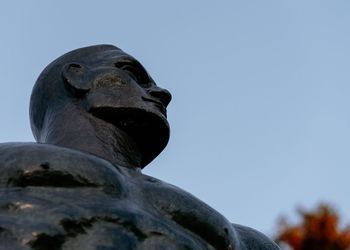The Central Station Spartans
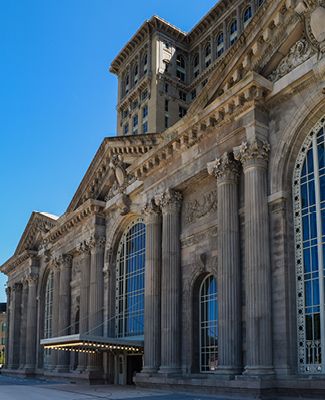
The Central Station Spartans
The long-awaited restoration of Michigan Central Station is complete. Meet the Spartan cohort helping revitalize the city of Detroit and its most iconic historic monument.
October 1, 2024Celia Giesey approached the careworn and crumbling colonnade that stood guard at the entrance to Michigan Central Station. At 83 years old, Celia’s step had slowed, but she was urged forward by what waited ahead. Excitement and trepidation clashed as she stared up at the historic Detroit monument.
For a moment, Celia was carried away by nostalgia. Her mind as sharp as ever, she drifted to her memories of the Beaux-Arts style landmark—the awe-inspiring waiting room cavernously capped with its vaulted terracotta domes, the ticket office teeming with travelers, the sun glowing through the concourse, and a maze of rooms for dining, shopping and socializing.
Through the doors, the present day pulled Celia back to the moment. Now in October 2019, the landscape felt both familiar and strange. The scenes from her memories had been dramatically altered by the harsh passing of time.
The train station—abandoned a generation earlier as Detroit struggled through economic decline and a withering demand for rail travel—was a shell of its former glory. When the building closed permanently in 1988, anything too large or worthless to haul away was scavenged and the heavy hammer of Michigan winters battered whatever was left.
The destruction was pervasive, but it was impossible to overlook the building’s innate grandeur. Celia smiled as her eyes roamed the room, taking in the gallery of crude graffiti, the slopping piles of dust and rubble, and the initial stages of a restoration crew ready to tackle the challenge.
Celia’s family followed quietly as she explored. Special access to the site had been arranged by her grandson, Austin Giesey, but Celia eagerly pushed ahead like a kid in a candy store and the family let her guide their tour.
Giesey, a 2014 Michigan State University graduate, is a Project Manager for The Christman Company’s Historic Preservation Group. Ford Motor Company tapped the Christman/Brinker Joint Venture to restore the splendor of the 647,000-square-foot building following its purchase of the property in 2018. When Giesey was assigned to the project in 2018, he knew how important it would be to bring his grandmother to this spot. He was raised on her stories of growing up in Detroit’s Corktown neighborhood during the city’s golden age in the ’40s and ’50s.
Celia saw the station at its best and now at its worst. When their tour ended, an emotional Celia turned to her grandson.
“I can’t believe it’s gotten to this point,” she said. “How are they going to restore it?”
The answer was complicated but struck at the very heart of a city endeavoring for its own story of rebirth. And for the dedicated Spartan alums at the core of the Christman/Brinker team, it became the ultimate test of aptitude and perseverance.
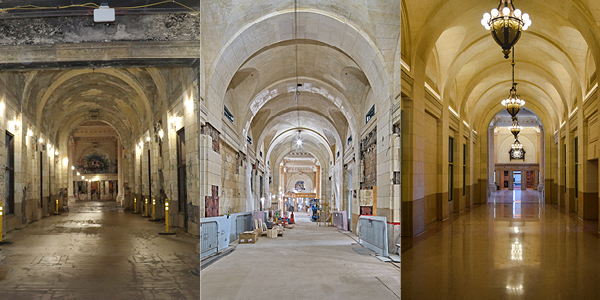
A PERSONAL STORY
Celia first arrived at the station in 1942 with her mother, grandmother and four sisters. They took the train north from West Virginia accompanied by the body of Celia’s father who had been killed in a coal mining accident.
The family settled in a house at 25th and Howard—just south of the station and old Tiger Stadium.
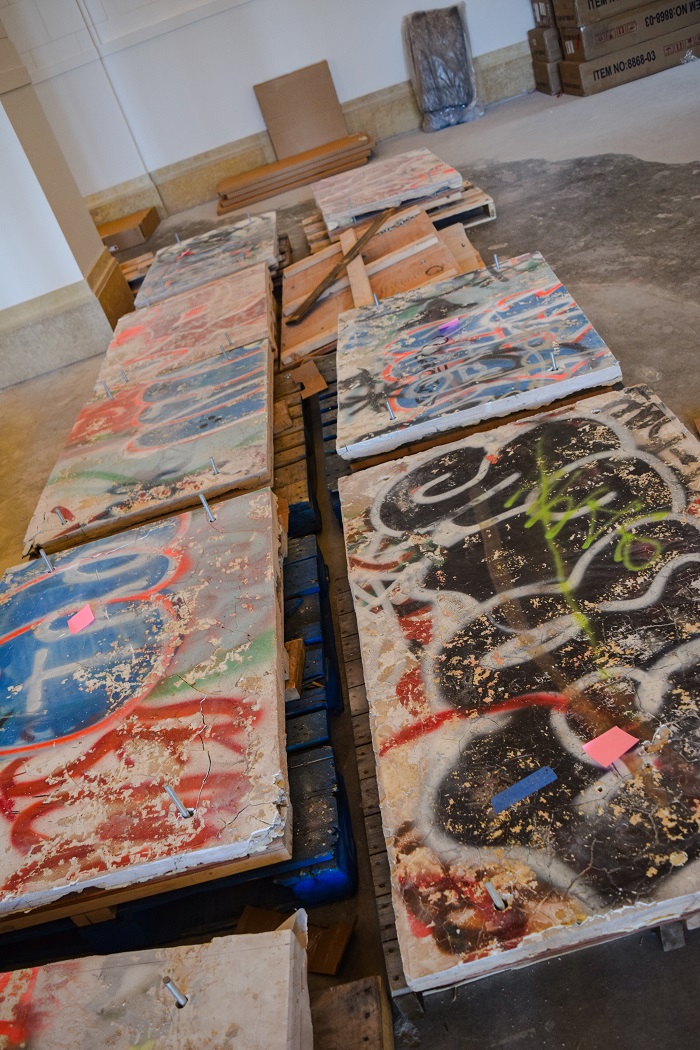
"Detroit was the place to be," Giesey said. "The city was so vibrant. Jobs were easy to come by. There was a rich culture in Detroit that really made everyone feel welcome."
The train station was the defining feature of south Detroit and life revolved around its campus. In the winter, Celia would trek through the snow with her church choir to sing Christmas carols in the waiting room. Other times, she would visit friends working in the shops or just watch the arrivals and departures, especially the tearful farewells to soldiers deploying for war.
Celia married and moved away in the ’60s, eventually raising her own family in Flint. She passed away in March 2024 before seeing the restoration’s finishing touches but proud of the part her grandson played.
Giesey oversaw the depot’s ground floor and mezzanine. He managed contracts with over 90 trade partners, and, at the project’s peak, played a role in the supervision of more than 550 laborers. The important work being done—a combined total of 1.7 million hours—helped Giesey feel connected with his family’s history.

And he wasn’t alone.
Douglas Norton served as Project Executive at Michigan Central for Christman/Brinker until his retirement in 2022. Norton, a 1975 MSU grad, was born in Detroit and remembers taking a train out of the station when he was 10.
“The station was bustling back then,” Norton said. “A lot of activity. A lot of people. A lot of trains. It was very exciting for a young boy to be around.”
Being part of the Christman/Brinker team meant restoring a small part of his childhood. But, like Celia, his reunion with the long-neglected station was emotional.
“I was alarmed,” he said. “It was alarming that anyone could’ve let it get to that condition.”
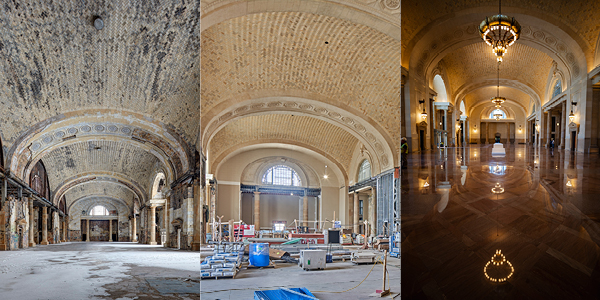
STARTING THE JOURNEY
When Bill Ford Jr. acquired Michigan Central, the task seemed almost insurmountable—and that was before the Christman/Brinker team discovered the harrowing complexities the six-year journey had in store.
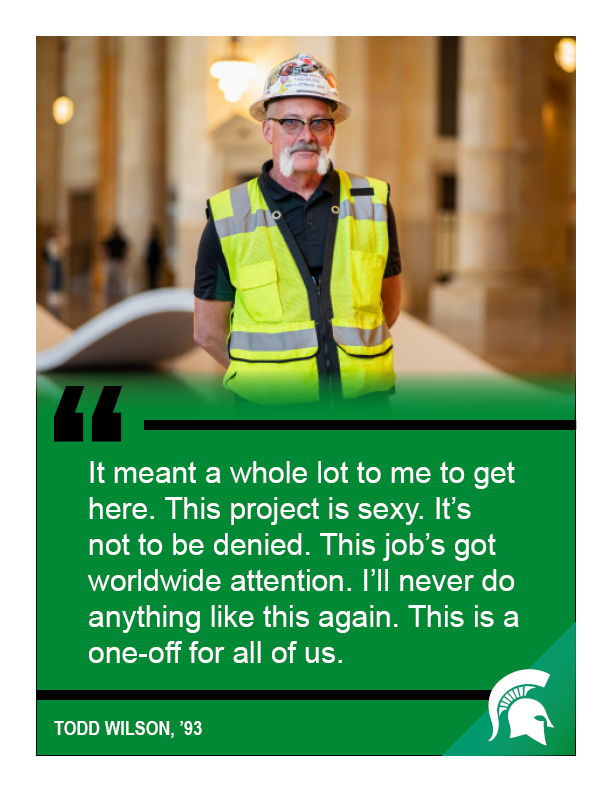 “I got there the first day without a thought in my mind what I’d be walking into,” Giesey said. “I was very motivated when you see this giant building with a ton of potential in front of you, and then you walk inside. Immediately the wind deflated from my sails. Where do you even start? There’s so many concerns and unknowns.”
“I got there the first day without a thought in my mind what I’d be walking into,” Giesey said. “I was very motivated when you see this giant building with a ton of potential in front of you, and then you walk inside. Immediately the wind deflated from my sails. Where do you even start? There’s so many concerns and unknowns.”
Giesey described the station as a blank canvas, but really it was somehow even less than that.
Thirty years of neglect had stripped the station to its bones with rusted beams, cracked columns, decayed ornament and dark cavities in the walls and ceilings revealing the depth of the detriment. A torrent of leaks and storms flooded the basement with 2.5 million gallons of rainwater. Several pumps and one year later, the team explored the previously submerged space only to discover an unknown sub-basement—a crawl space unaccounted for in the original floorplans.
The cramped, water-logged chamber further uncovered the extent of the damage. Unrelenting moisture had deteriorated sections of the support structure requiring critical repairs before the restoration could continue. Their efforts were delayed by a massive storm in the summer of 2021 that overwhelmed the drainage system and re-flooded the basement levels.
Once the leaks were finally plugged, the area was secured to prevent future water damage and then backfilled with 22,000 yards of concrete.
With nearly 50 years in engineering and construction management, Norton thought he had seen it all. But nothing compared to the problems faced at Michigan Central.
“This was certainly in the worst condition from neglect over the years,” he said. “But we had a very good team. They understood the task at hand. They had a product that they had to deliver, and they were willing to rise and go above and beyond to do that.”
The Christman/Brinker group was divided into four teams, each with a project manager, superintendent and engineer. A small number of additional people operated in support roles. In addition to Giesey and Norton, Spartans were woven into each layer with nearly half being MSU graduates.
Mike Davis (’20, Construction Management) was engineer for the ground floor and mezzanine, Gilchrist Ireland (’18, Civil Engineering) was engineer for the envelope and exterior, Dominic Adams (’09, Urban and Regional Planning) was engineer for the 18-story tower, and Todd Wilson (’93, Philosophy) was superintendent for the MEP and basement team. Additional Spartan support came from Project Estimator Nikki Welch (’10, Urban and Regional Planning), Director of Preconstruction Dwight Hooks (’93, Construction Management), and intern Sam Linebaugh (’22, Urban and Regional Planning).
“All of us were able to achieve an excellent education at MSU,” Norton said. “A lot of the skills, attributes and attitudes that Christman looks for in their employees show in Spartan alumni.”
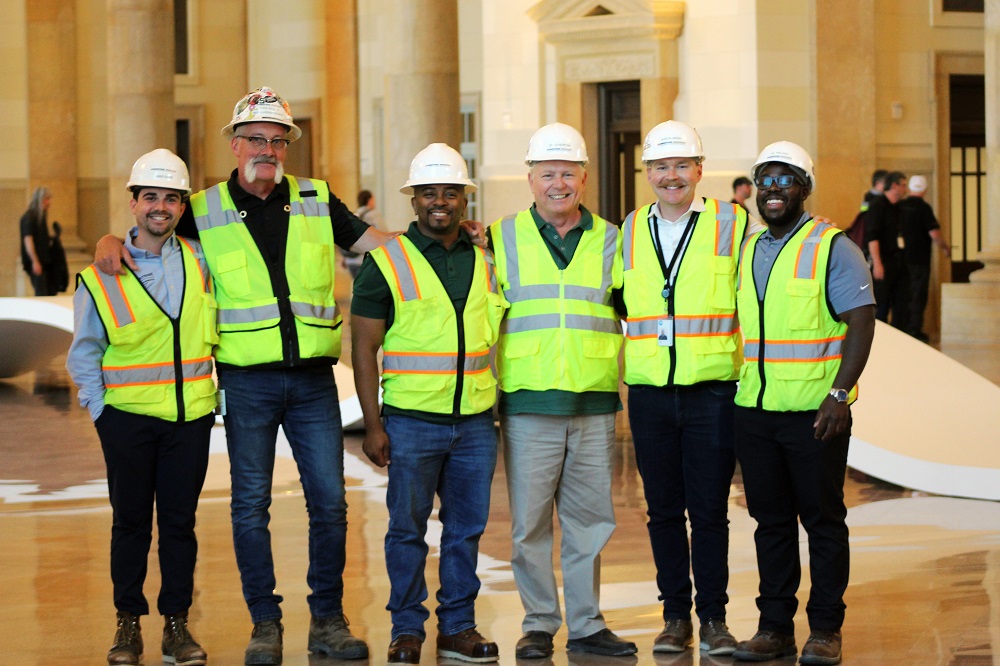
THE SPARTAN WAY
As a student, Giesey was employed by MSU’s office of Infrastructure Planning & Facilities as an assistant project representative. Among his assignments was the restoration of Chittenden Hall in 2014.
Constructed in 1901, Chittenden was the university’s dairy operations center, later turned into the home for the Forestry department and then office space for the Graduate School before being shuttered in the ’90s. The building is listed on the state register of historical sites and was Giesey’s introduction to historic preservation. It gave him an appreciation for the niche labor that has dominated his recent career.
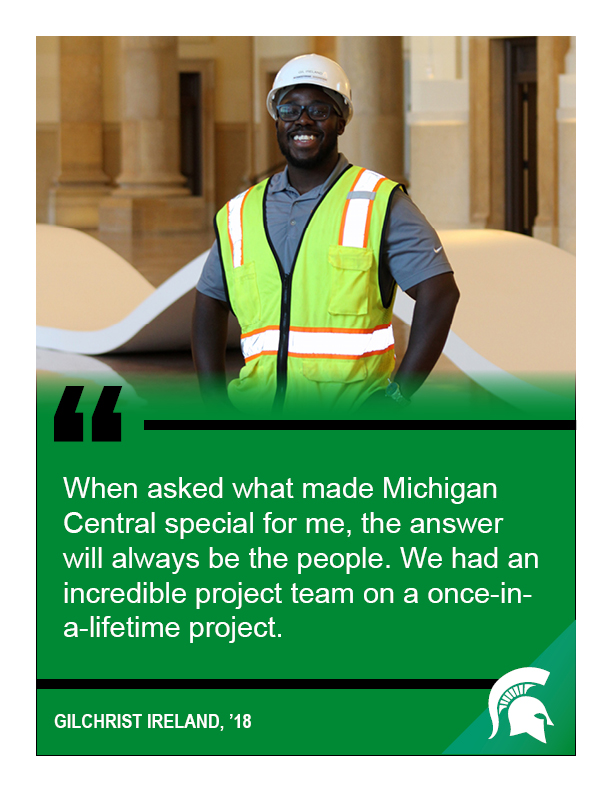 “There’s an excitement using an existing resource for a new purpose,” Giesey said. “There’s a history. People have made memories there. They’ve had their own experiences decades before and you’re able to maintain that feeling. That’s really what led me to choose Michigan State over other schools—that they invested in those resources.”
“There’s an excitement using an existing resource for a new purpose,” Giesey said. “There’s a history. People have made memories there. They’ve had their own experiences decades before and you’re able to maintain that feeling. That’s really what led me to choose Michigan State over other schools—that they invested in those resources.”
The university has embraced using students on similar projects over the years and not all of them are part of the construction management program. Engineers, architects and even communications majors have cut their teeth with real-world experience in the field.
“It’s a good way to get them exposure as they’re going to school,” said MSU project manager Andy Linebaugh who worked closely with Giesey at Chittenden. “If you ask any of them, they would say to a person that it was advantageous to competing for jobs once they graduated.”
Linebaugh remembers Chittenden as one of his favorite projects over the past 17 years as a university employee and praised Giesey’s contributions. Like the train station, the challenges required a keen ability to problem solve. How do you preserve historical integrity while shaping the existing structure to meet modern-day infrastructure needs and regulations?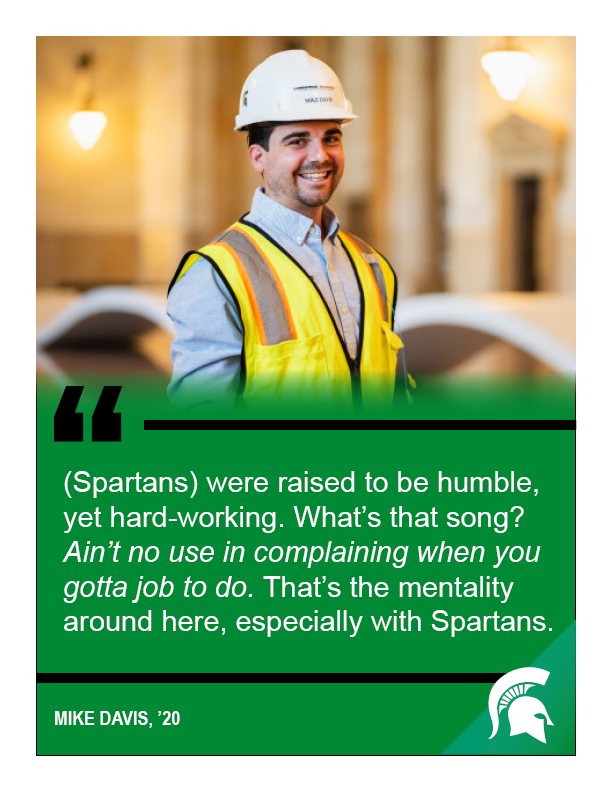
Chittenden, for example, required creative use of the limited existing space to incorporate an HVAC system anachronic to the period it was built. Air intakes for the system were hidden behind rebuilt dormers that were part of the original construction but had been removed sometime before 1912.
A common thread connecting many of MSU’s preservation projects is Christman. The company and university have a close partnership dating back to 1908. Todd Wilson, an MSU employee for 27 years before joining the Christman team at Michigan Central, estimates that up to 90% of the buildings on campus were either constructed or renovated by Christman. It’s no surprise that so many of the company’s employees come out of East Lansing.
"Throughout my career, the number one thing that was most important was problem-solving,” Norton said. “All the different projects, all the different companies, all the different challenges were all focused on solving problems. My problem-solving skills were enhanced and developed right there at MSU. At Michigan Central Station, there were many problems and challenges that had to be solved and solutions that had to be found. That skill, that attribute is important in all the things we do in this industry."

LOOKING TO THE FUTURE
The complex problems at Michigan Central have been well-documented leading up to the grand re-opening. The persistent leaks and flooding in the basement were just the start. Reconstructing many of the lost features required sometimes extraordinary measures and occasionally a stroke of luck.
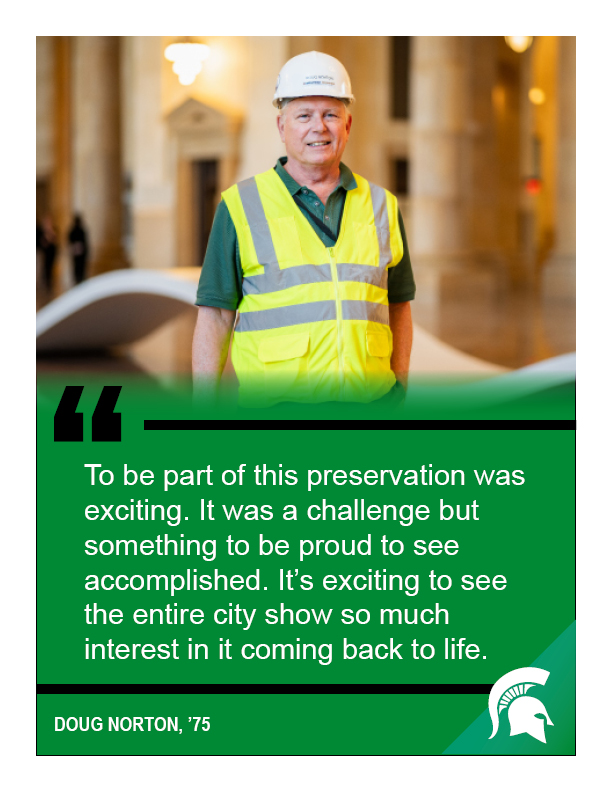 The building’s limestone blocks were originally from an Indiana quarry that closed the same year as the station. The team’s expertise and meticulous research eventually led to the original source and unused stockpile of perfectly matched blocks long forgotten in the forest. Millions of dollars were spent to reopen the quarry and ship 8,000 cubic feet of new limestone, or approximately 300 blocks, up to Michigan.
The building’s limestone blocks were originally from an Indiana quarry that closed the same year as the station. The team’s expertise and meticulous research eventually led to the original source and unused stockpile of perfectly matched blocks long forgotten in the forest. Millions of dollars were spent to reopen the quarry and ship 8,000 cubic feet of new limestone, or approximately 300 blocks, up to Michigan.
Archival photos were critical to help match missing elements, but exact facsimiles were difficult to reproduce without the original artifacts. In one case, a serendipitous phone call helped return one of the original ornate transoms that topped the elevator doors. Without that tip, those pieces would have been difficult or impossible to reproduce.
“We made it a point—and the Christman culture itself makes it a point—to chase down every lead,” Giesey said. “We wanted to make sure to investigate those things as thoroughly as possible to restore the fabric that was here."
Matching the original construction methods was another time-intensive process. The Guastavino vaulted ceilings in the waiting room required 29,000 individual terra cotta tiles, each about the size of a half sheet of paper covering a 21,000-square-foot surface area. The layered, detailed work took a year to complete.
However, the building isn’t a perfect replica in every way. By design, many bricks and tiles were left with chips and dents, untouched sections of graffiti are on full display and curated examples of ruin remain in place. It’s all about telling the story of the station’s renaissance—from its groundbreaking, to its glory days, to its fall, and now its revered revival.
Michigan Central Station is only the beginning for Detroit.
"There's still a lot of work to be done,” said Joe Luther (’08, Construction Management), Christman Senior Vice President and General Manager for SE Michigan. “There's been incredible progress in the last 10 years, but there's still such a long way to go and there's still a lot of passion in developers to get us there. I think the next 10 years are going to be as exciting as the past 10, and we're going to continue to see it push out from the downtown area into other pockets of the city and we're excited to be along for the ride."
A week before the grand re-opening of Michigan Central as a mobility and innovation hub, Giesey returned wearing his white hard hat and bright safety vest—now appearing out of place in a building that had become his second home. Preparations were well underway for the city’s 10-day celebration to commemorate the event. A temporary concert stage for Detroit musical icons stood on the spot where his grandmother made her emotional approach back in 2019.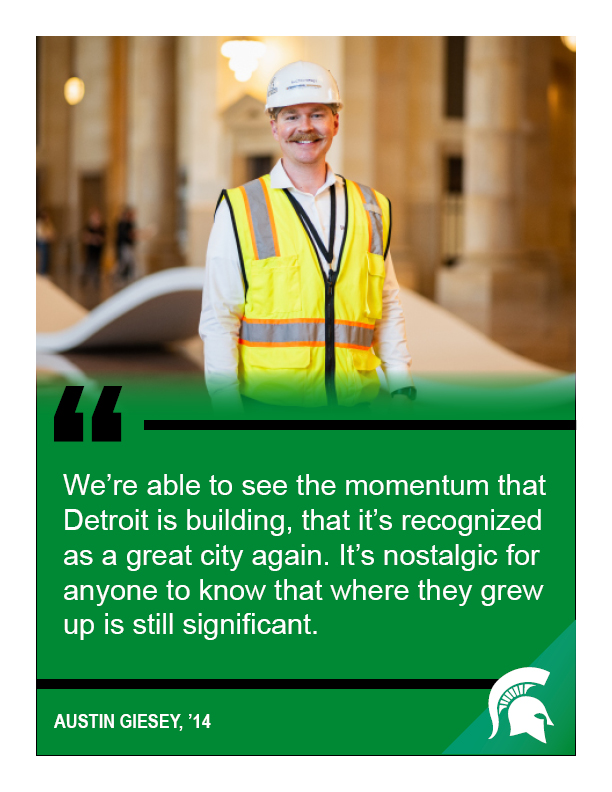
Her words still rang in his head, her pressing question finally answered.
I can’t believe it’s gotten to this point. How are they going to restore it?
“She would’ve been happy that the next generation gets to experience the building how she did,” Giesey said. “That people were going to walk in there and see what Detroit once was and what it can be again. We’re able to see the momentum that Detroit is building, that it’s recognized as a great city again. It’s nostalgic for anyone to know that where they grew up is still significant.”
